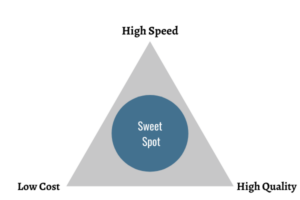When it comes to construction, the top three concerns on the mind of every building owner and developer are cost, quality, and speed.
Everyone wants their project to be of the highest quality at the lowest cost, and for it to be done in as little time as possible. It is why we have built Peak Development Partners on the promise of delivering your finished product “on time, on budget, or better.”
There is an old adage: “Good, fast, cheap… pick two.” We find this to be an oversimplification, but there is some truth to it. Very often on a project, cost, quality, and speed do compete with one another, based on your priorities.
This graphic illustrates the competing nature of cost, quality, and speed:

As you move towards any one tip of the triangle, you are logically moving away from the other two. So, If you decide to focus more on shortening your schedule (speed), you will often have to sacrifice quality, and will almost certainly increase your overall cost. If your aim is to reduce cost, quality tends to suffer, and it will likely take you longer to finish.
Managing cost, quality, and speed is a balancing act that every owner and developer has to contend with. We have found that the solution always comes down to a simple consideration: what are the goals of the ownership and development team?
A clear understanding of those goals is crucial to minimizing how much you will have to sacrifice certain points of the cost, quality, speed triangle in favor of others.
In this article, we will focus on how owners and developers always aim for the highest quality, and the impact that can have on both cost and speed.
Quality
In construction, quality can be looked at in two ways.
First is the level of quality to which something is being designed. So, for example, the difference between a standard apartment and a luxury apartment. In higher end buildings, the quality is obviously much nicer, and that impacts the overall cost/quality/speed equation because as components get more expensive, they become harder to get, which can dramatically increase your lead times.
And, of course, that also works against cost. The faster you want to get something, the more expensive it is going to be.
So when you’re dealing with luxury products, you want to order them early, so that you receive them within your overall construction schedule.
Geometry also comes into the quality conversation quite a bit. If you’re building things that are in standard geometry, like a rectangle, that is typically pretty easy and will move the process along faster. It will also help keep costs down because labor will be less expensive.
But, when you are trying to build things that are more complex geometrically, it takes more time, there is more care and attention to detail that is required, and all of that adds up to higher costs.
The second way of looking at quality is by the quality of what is being built. This refers to the overall level of workmanship. So, if you want something done with quality, you want it built per specification, and nothing less.
Poor workmanship can show itself in many ways. For instance, in a previous post, we talked about how developers often think they are saving money by cutting corners on things like cheaper, lower-quality sound reduction materials.
Sometimes it is simply the case of having the wrong workers on your team. Case in point, bathtubs are installed early in the construction process. Then drywall, ceramic tile, and other things are installed. Often you will find workers who are largely unconcerned with quality. They’ll do things like stand in the bathtub, or store garbage in it, all of which can cause damage. The quality-driven workman aims to protect the finishes of materials that have already been installed in order to maintain the highest quality for the finished product.
Protecting these items requires extra time and extra money, though. To protect the bathtub in our example, you can put plastic or cardboard in the tub so that it doesn’t get damaged, but it costs money for the materials and labor to install it.
Blemishes like these, which are the products of poor workmanship, all add up to a negative experience for your tenants and guests. Poor workmanship is tangible. The final user of the building (the tenant in an apartment building, for instance) is going to not only see it, but feel it, and experience the lack of quality overall. Negative experiences cost money, no matter how much you think you’re “saving” by cutting costs.
You expect from every contractor that they will provide and install every product with a high degree of workmanship. That applies to both what is considered “high-end” and “low-end.” As we’ve just learned, this doesn’t always happen automatically. So, what do you do?
Not surprisingly, applying the four tenets of DIT Development (build your team early, leverage your team’s talents, protect your time, and manage your project proactively) can help to ensure your workmanship, and in turn, preserve your time and money.
Building your team early allows you to mead out the workers who might end up costing you through poor workmanship. Leveraging your teams’ talents can help you spot more complex aspects of your project and help you plan for how to finish them on time, on budget, or better.

